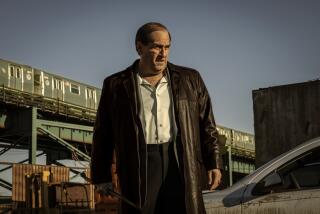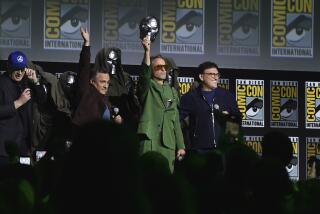Spider-Man team spills secrets of ‘Far From Home’ post-credits scenes and Marvel’s future
“Spider-Man: Far From Home” marks an end to 10 years, three phases and 23 films worth of storytelling for the Marvel Cinematic Universe.
The Sony and Marvel production, now playing pretty much everywhere in the world, follows on the heels of April’s epic “Avengers: Endgame” by exploring how Peter Parker is grieving the death of his mentor, Tony Stark, while simultaneously attempting to free himself from Iron Man’s superhero shadow.
“The emotional journey [of this film] is so closely tied to ‘Endgame,’” said Marvel Studios President Kevin Feige. “Really, it feels like this was the finale of that saga, because of how it connects very directly to the first ‘Iron Man’ at the beginning. Early on we decided that this was the capper on a deep, personal, emotional level after the big, galactic events of ‘Endgame.’”
In some ways, Feige said, Peter’s pressure to measure up to Iron Man mirrors Marvel Studios’ own self-imposed pressure to deliver follow-up films as epic in scale and storytelling as the Infinity Saga.
“Over the course of all 23 movies that we’ve made so far — every single one of them starting with ‘Iron Man’ — we’ve put this pressure on ourselves to do something unique and different and exceed expectations,” he said. “That’s certainly the same going forward.”
‘Spider-Man: Far From Home’ lays the groundwork for the future of Marvel and Tom Holland »
Creating one of the most successful and intricate cinematic universes in history was no easy feat, Feige said. Among the challenges were producing 2008’s “Iron Man” without a studio partner for the first time, getting filmmakers and audiences to understand the interconnected web being woven among the films and choosing to introduce new characters such as the Guardians of the Galaxy, Black Panther, Doctor Strange and Captain Marvel in the midst of the massive success of already established franchises such as the Iron Man and Avengers sequels.
“So it was all challenging,” said Feige. “And then setting ourselves up four years ago by announcing both ‘Infinity War’ and ‘Endgame’ as the big conclusion to the saga. It would’ve been very embarrassing if things didn’t work.”
The release of “Far From Home” was announced between the two “Avengers” films despite Spider-Man’s apparent death in “Infinity War.” For Tom Holland, who plays the MCU’s iteration of the web-slinger, keeping the timeline of “Far From Home” under wraps for over a year was extremely difficult.
“We were never totally honest with whether it was a prequel or a sequel, but it was really just to preserve the cinematic history of ‘Endgame.’” he said. “The moment in that film [when Iron Man dies] will forever go down in history as one of the most monumental moments in cinema and we wanted to preserve that as much as possible.”
While “Far From Home” grapples with the collective grieving over Iron Man’s death, it also briefly explores the fallout of Thanos’ galaxy-leveling snap. The people who disappeared and reappeared — including Peter Parker and many of his friends — survived what is now referred to as the “blip.”
“The way we deal with the snap is very serious, but there’s a real comical tone to it,” said Holland. “Imagine if half the world disappeared for five years, and then at the snap of your fingers came back, there’s going to be some funny stories.”
The Times caught up with Feige, Holland and director Jon Watts to discuss the close of Marvel’s third phase, what’s to come for Spider-Man and the latest epic post-credits scenes.
[Warning for those who haven’t yet seen “Spider-Man: Far From Home.” There are spoilers ahead.]
IRON MAN’S LEGACY
Why was it important to include that scene in the jet where Peter evokes Tony?
Jon Watts: To me, that’s the cathartic moment for Peter. This whole story is about him running away from how he feels and from this responsibility and basically lying to himself about his emotions. So I knew the whole movie was sort of building up to that moment where he finally just breaks down and tells Happy the truth about how he feels and all of his insecurity.
Tom Holland: The whole AC/DC thing was an idea that Jon and I came up with on the day. As soon as it came into play it was like, “Wow, we should really try to re-create that scene in ‘Iron Man.’” I went back and watched the scene of Robert [Downey Jr.] and tried to re-create his movements. It was a real dream come true.
What was more difficult to shoot, Peter’s ‘death’ in ‘Infinity War’ or Tony’s death in ‘Endgame’?
Holland: Tony’s death in “Endgame.” The death scene in “Infinity War” was surprisingly not emotional. We were all having a really good day and it was kind of fun. Obviously you turn it on when you need to turn it on, but I’m lying in Robert’s arms and then I die and I look off, but obviously I don’t go anywhere. I’m just lying in his arms, trying not to be distracting. And he’s doing the scene and he’s crying and rubbing his hands like, “Where did he go?” And I’m like, “I’m right here, dude, I’m right in front of you!”
UP NEXT
How long does it take to develop each phase in the MCU?
Kevin Feige: About five years. There’s always changes to it, we always alter a little bit from the course, but setting a five-year path has been very beneficial to us since the beginning.
We’ve been working on [Phase 4] for the last four years. As we’ve been producing these films, we’ve been developing and planning the next group of films and looking to continue to surprise [fans] and bring characters to the screen that are very different from any characters before and that people, unless they’re really hard-core comic fans, may not have heard of.
The theory of the multiverse is introduced and discarded pretty quickly after Mysterio is revealed to be a fraud. Could it come into play somewhere down the line?
Watts: We never say it’s not real. Mysterio’s take on it is certainly bull, but that doesn’t mean that a multiverse couldn’t exist, especially after the things that we saw happen in “Endgame” with different timelines.
Feige said the theory “definitely could” come into play in upcoming films.
Feige: This is the second time we’ve heard tell of the multiverse in the MCU. This time being from a fraud, but the first time being from Tilda Swinton’s character the Ancient One in “Doctor Strange.” And she’s a much more trustworthy source.
Could we see a crossover with ‘Spider-Man: Into the Spider-Verse’?
Holland: At one point there was a moment where I was going to play a Peter Parker in that movie. There was going to be a little Easter egg or something.
What’s the likelihood of well-known Spider-Man villains like Doc Ock and the Green Goblin being introduced in future Spidey films?
Watts: I like always trying to find characters and stories that we haven’t seen before on the screen, but that doesn’t mean that it’s out of the realm of possibility that we could see someone in a Spider-Man film that might’ve already been in a previous [movie].
POST-CREDITS SCENES
How does having his identity revealed change things for Peter?
Watts: That’s something that we’ll start figuring out as soon as the press tour is over and the movie’s in theaters. Nothing like painting yourself into a corner to inspire creativity.
Holland: It’s very exciting because you get to start the third film on grounds you’ve never explored before. But how it directly affects him, we’ll have to wait and see because I don’t know just yet.
How will things change for Peter now that he’s public enemy No. 1?
Holland: If you blew up [London’s] Tower Bridge, you would be the most wanted human being on the planet. And we all love Peter Parker and he’s such a sweet guy, it’s really exciting to see what happens when every single government in the world wants him dead, I’d guess.
The idea of Spider-Man being a villain gets explored a lot [onscreen], but it really changes things when you know that he’s also a 16-year-old kid from Queens. I’m thinking about how the world is going to react when their new Iron Man is revealed to also be just starting his junior year.
How does the revelation that Talos had been impersonating Fury affect everything that’s happened?
Watts: For me, the biggest benefit is it explains how Mysterio could fool Nick Fury because Fury’s superpower is suspicion and yet he’s fooled by Mysterio. It’s fun to watch the movie again knowing that and you realize all the conversations between Nick and Maria have a secondary meaning when you realize that that wasn’t actually Nick and Maria.
But where exactly is Fury?
Watts: It’s definitely a Skrull spaceship. But I don’t know if I can specifically say where they are. They’re in space. He’s on a mission, but he got to take a very brief vacation on this little relaxation pod.
Twitter: @sonaiyak
More to Read
Only good movies
Get the Indie Focus newsletter, Mark Olsen's weekly guide to the world of cinema.
You may occasionally receive promotional content from the Los Angeles Times.











